Language
- Deutsch
- English
- Español
- Français
- Italiano
- Nederlands
- Português
Currency
- AUD Australian Dollar
- CAD Canadian Dollar
- EUR Euro
- GBP Pound Sterling
- SGD Singapore Dollar
- USD US Dollar
- ZAR Rand

Discover the jewel of eastern Zambia, South Luangwa National Park. The park comprises approximately 9,500 square kilometres of unspoilt wilderness and a truly impressive collection of wild- and birdlife. Not only is it a remote and wild safari destination, but it's the birthplace of walking safaris with the pioneering excursion in 1950 by British Conservationist, Norman Carr.
South Luangwa National Park is home to around 400 of Zambia's 732 currently recorded aviary species and roughly 60 wildlife species, including several endemic to the area. The trick to truly experiencing the best of this park is identifying when to go to, and the best places to stay in South Luangwa.
With an array of accommodation options available, the decision of where to stay comes down to preference. Whether the focus is on amenities and activities or based on a must-see safari sightings list, there is something for every traveller. With that in mind, allow us to introduce you to some of South Luangwa's wild residents and provide a wildlife guide to a Zambia safari.
Despite the Green Season (November – April) being beautiful with lush landscapes and brimming waterholes, the dry season (May – October) is actually considered the best time for wildlife sightings. While that may seem counterintuitive, reduced water levels in the dry months draw wildlife to the remaining sources and increase the number of sightings. However, each season presents its own unique opportunities and our African Safari Experts will tailor-make an itinerary that works best for you and your interests.
The below table is a list of wildlife in South Luangwa that can be seen on game drives, walking safaris, and even boat excursions, and how often you can expect to encounter them.
| South Luangwa Wildlife | Sightings |
|---|---|
| Elephant | Abundant |
| Thornicroft's giraffe | Common |
| African Wild Dog | Occasional |
| Lion | Common |
| Leopard | Common |
| Cape Buffalo | Common |
| Spotted hyena | Common |
| Hippos | Abundant |
| Crawshay’s zebra | Abundant |
| Cookson’s wildebeest | Common |
| Eland | Occasional |
| Roan antelope | Rare |
| Sable antelope | Rare |
| Puku antelope | Abundant |
| Duiker | Occasional |
| Impala | Abundant |
| Kudu | Common |
| Pangolin | Rare |
| Aardvark | Rare |
Loxodonta africana
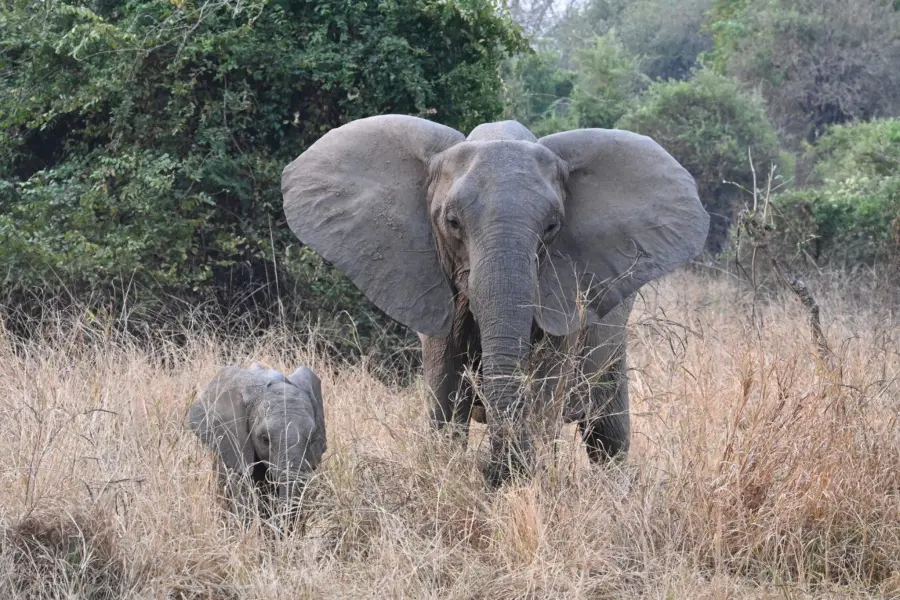
Elephants are the most visible members of the Big 5, not only due to their size, but in sheer numbers. These magnificent mammals are the world's largest land animal and travel in close-knit social herds. They are extremely intelligent and often prove the sentiment ‘an elephant never forgets' to be true.
While their large ears help to keep them cool under the African sun, they are often seen in bodies of water spraying themselves to keep cool. Their trunks are a complex set of muscles strong enough to rip off branches, but agile enough to lift a feather, while also being their primary form of communication. Elephants form strong bonds and can be seen grieving members of their herd and performing basic burials.
Where Can You See Elephants in South Luangwa?
Thanks to their numbers, elephants are frequently seen on game drives. Their presence is most common along the Luangwa River, its tributaries and, interestingly, in the reception area of Mfuwe Lodge! Around October, these gentle giants meander through the reception area to get to their favourite mango tree, a time when you can enjoy seeing them from a respectable (and close) distance.
Giraffa camelopardalis thornicrofti
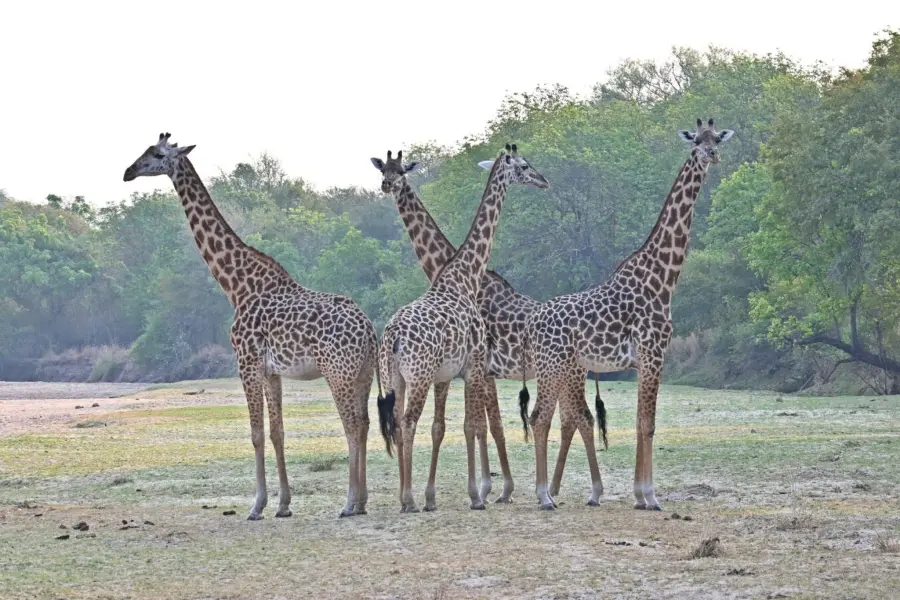
While giraffe may seem like a standard safari sighting, these particular giraffes are a subspecies endemic to South Luangwa, known as Thornicroft's giraffe. After being separated from the original giraffe population, the isolated group adapted more specifically to their environment. These changes may not be immediately obvious, but include a shorter stature and slightly different markings – for example, the pattern on their hide doesn't extend below their knees.
Where Can You See Thornicroft's Giraffe in South Luangwa?
These lofty creatures are a common sighting throughout South Luangwa. Towers of giraffe travel in groups of up to 20 and are often seen tracking down thorny acacia trees or adopting their distinctive ‘A-frame' stance by a watering hole.
Lycaon pictus
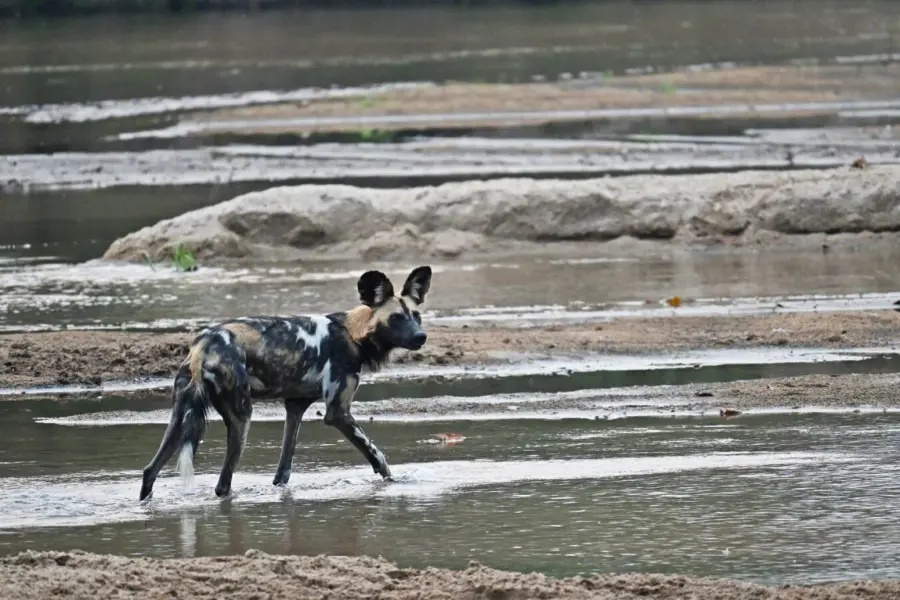
Known as Africa's ‘Painted Wolves' due to their mottled, camouflage-esque coats, each one is unique. Due to their endangered species status, ample conservation efforts are working to stabilise and increase the current population.
These social animals form strong bonds within their pack, usually made up of 10-20 individuals, and are led by a monogamous pair of alpha dogs. This nomadic species is known to hunt in packs and rely on sight rather than smell to locate prey, achieving an 80% success rate due to their advanced communication methods. They are widely considered one of the rarest and best wildlife sightings in Africa.
Where Can You See Wild Dogs in South Luangwa?
Fortunately for those in search of ticking this sighting of their bucket-list, the Luangwa Valley is home to a well-established wild dog population, and is a great place to see wild dogs. Their preferred habitats include deserts, forests, and grasslands.
Panthera leo melanochaita
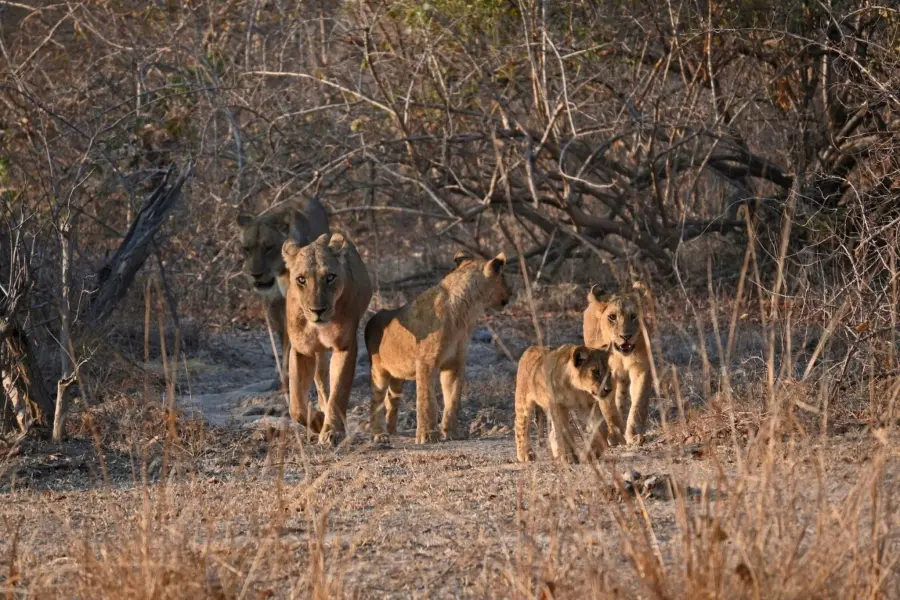
Not only are these big cats one of the Big 5, but they are one of the most recognisable wild animals. While they may be crowned king and queen of the jungle, they are incredibly social and live in groups of 10-15 individuals called prides. Cub rearing is a group activity and all lionesses are responsible for the prides' offspring, but they are also in charge of hunting. As lionesses are smaller and more agile, they hunt as a team to bring down prey, but eat in a hierarchy with the adult males eating first.
Where Can You See Lions in South Luangwa?
South Luangwa is home to Zambia's largest lion population and various prides can be found primarily on the eastern side of the park near the Luangwa River. Interestingly, the current prides inhabiting the area come from a group called ‘Big Pride', which was a super pride of 30+ lions that split into three groups within the Mwamba area.
Panthera pardus
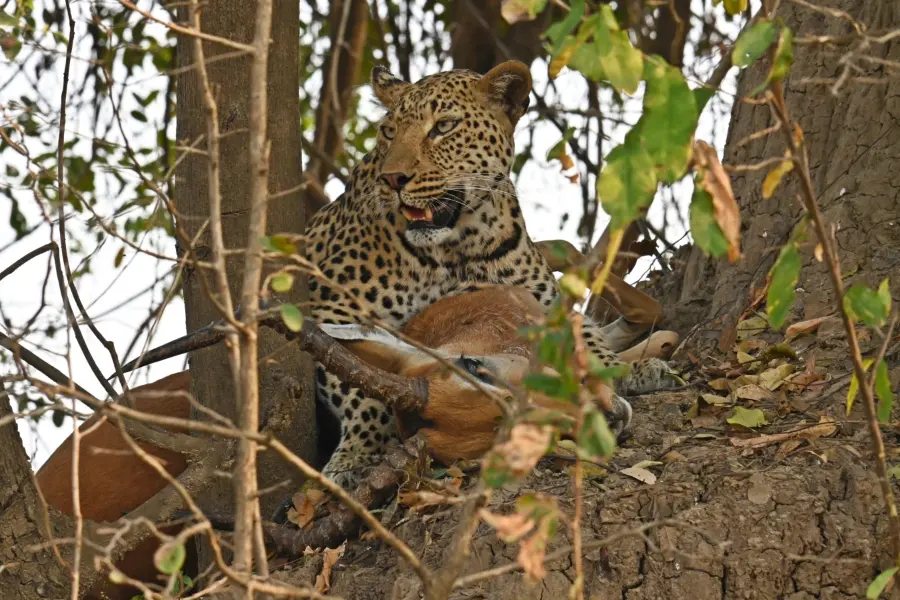
South Luangwa National Park is known as the ‘Valley of the Leopard' with one of the highest densities of leopard in the world. Unlike the other big cats, leopards take solace in the park's large trees and some of the most enthralling sightings entail them dragging their pray up a trunk and onto a sturdy branch. During the dry season (mid-June to the end of October), leopards can be spotted solo hunting in the cool early mornings and later evening. Despite being expert stalkers with a pounce distance of around 6m, leopards are also fast on their feet reaching up to 58km/h (36mph).
Where Can You See Leopard in South Luangwa?
The Nsefu Sector of South Luangwa National Park is a popular predator hotspot, but thanks to the sheer density of leopards in the area, sightings of this Big 5 cat are plentiful.
Syncerus caffer caffer

Rounding out the fourth and final member of the Big 5 to be found in South Luangwa National Park, buffalo are most easily identified with their distinctive horns – think of a Viking helmet on their heads – called a boss.
Buffalo have formed a symbiotic relationship with Oxpecker birds who sit atop grazing herds removing any ticks or insects. While helpful for pest control, the birds also provide a good warning signal for approaching danger. Buffalo are often seen wallowing in mud to remove any insects or skin parasites and creating a ‘second skin' to prevent more.
These cattle-like mammals form matriarchal herds of up to 400 and are very protective of their herd – when attacked, they position their young and weak in an outward facing circle and lower their heads to create a near impenetrable circle of sharp horns. Herds can also coalesce to create huge social gatherings in excess of 1000 individuals, a deterrent to their constant threat, lions.
Where Can You See Buffalo in South Luangwa?
South Luangwa National Park has a large population of buffalo, which are most easily seen in the dry season at one of the many watering holes. During the green months, herds move around in search of fresh grazing more frequently.
Crocuta crocuta
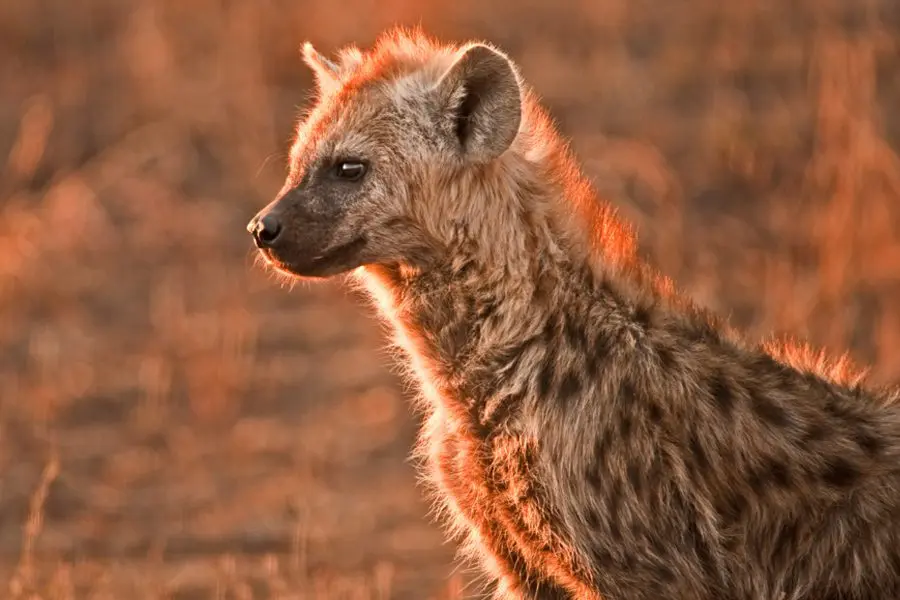
Spotted hyena are the largest and most common hyena species, recognisable through their furry spotted coats and round ears. Their far-reaching ‘whoop' can be heard up to 5km from the caller and are part of the symphony of sound in the night air. While they are typically categorised as scavengers, they are incredibly successful hunters. Hyena clans are large, up to 50 individuals, and led by an alpha female. The clan's claimed den is the hub of all clan activity, including where cubs are raised.
Where Can You See Spotted Hyena in South Luangwa?
Spotted hyena are a fairly common sighting in the park and can be seen sunbathing at the den or cooling off in mud wallows when it's really hot. On foot, hyenas are most easily tracked by their whitened droppings from the amount of bone they consume, affectionately dubbed ‘bush meringues'.
Hippopotamus amphibius

South Luangwa National Park, and the Luangwa River in particular, is hippo mecca. The park is thought to have one of the biggest hippo populations and they can be heard honking on and off throughout the day. Despite their mellow appearance as they wallow semi-submerged in the river, hippos have the strongest bite of all land animals and can reach up to 30km/h (19mph) on dry land. Hippos are also well adapted to living under the African sun and secrete a special oil which acts as a type of sunblock.
Where Can You See Hippos in South Luangwa?
Most easily spotted dwelling in the Luangwa River.
Equus quagga crawshayi
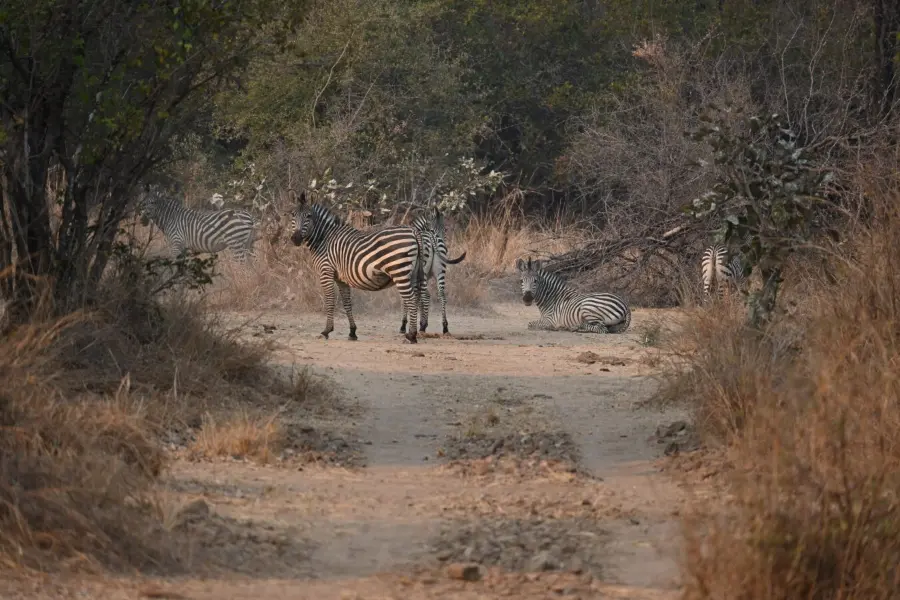
Crawshay's zebra is often mistaken as being endemic to South Luangwa as they are frequently seen in the area, however, they are also found in Malawi, Tanzania, and Mozambique. They are distinguishable from the more common plains zebra by their incisors and their narrower stripes, which are unique to each animal. Fun fact: a group of zebra is called a ‘dazzle' and for good reason; when a herd is being stalked by a predator, their moving stripes cause confusion making it difficult to pick just one out.
Where Can You See Crawshay's Zebra in South Luangwa?
Zebra are a common sighting during a South Luangwa safari game drive.
Connochaetes taurinus cooksoni
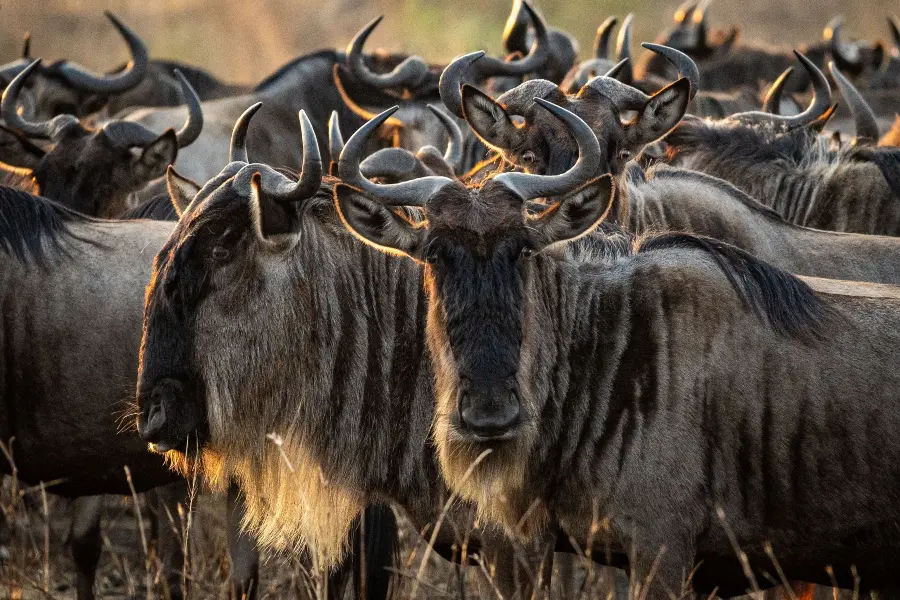
One popular African fable says that when God came to create the wildebeest, he used the ‘left over' body parts from other animals – which would explain its unorthodox appearance. The wildebeest is said to be a buffalo's horns, a locust's head, the body of a cow, the tail of a lion, and a goat's legs – an odd combination to say the least!
Endemic to the area, these patchwork creatures thrive on grass plains and are willing to travel longer distances for water. A subspecies of the more common blue wildebeest, Cookson's wildebeest are notably lighter in colour, tend to be slightly larger, and have unique markings and patterns on their face and neck.
Where Can You See Cookson's Wildebeest in South Luangwa?
Cookson's wildebeest is endemic to Luangwa but tend to be most commonly found in the northern parts of South Luangwa National Park.
Taurotragus oryx
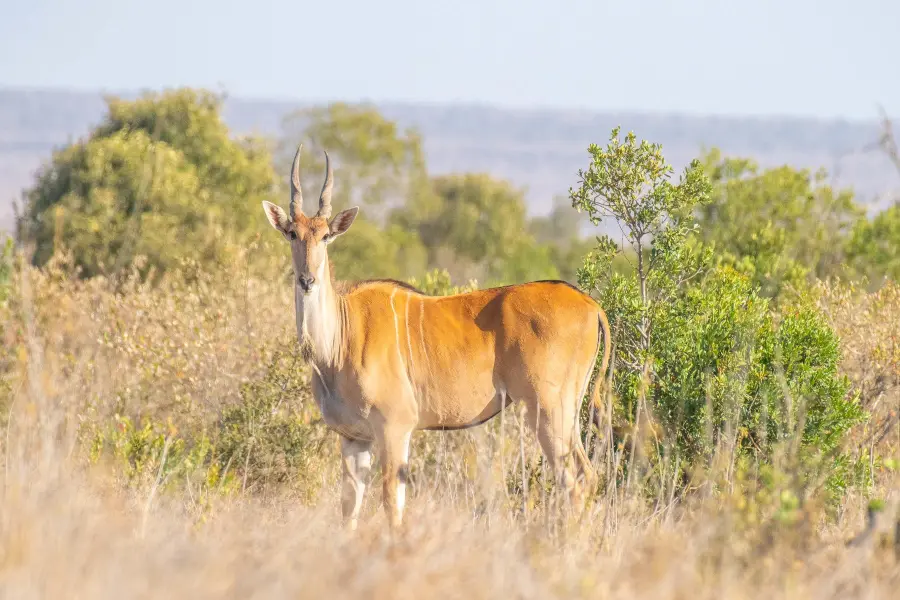
Eland is not easily missed when seen due to their sheer size, on the males side at least, reaching a shoulder height of around 1.7 metres with a weight of 900kg. When looking at them from the side, a slight hump is visible from the base of their neck and their long horns extend backwards. Female eland are both lighter and smaller, but still a stocky build, which makes their agility and ability to leap fences surprising. Feint vertical stripes are just visible on their flanks.
Where Can You See Eland in South Luangwa?
As a notoriously shy species, sightings of eland are not guaranteed, but are usually found in the Nsefu Sector of the park.
Hippotragus equinus
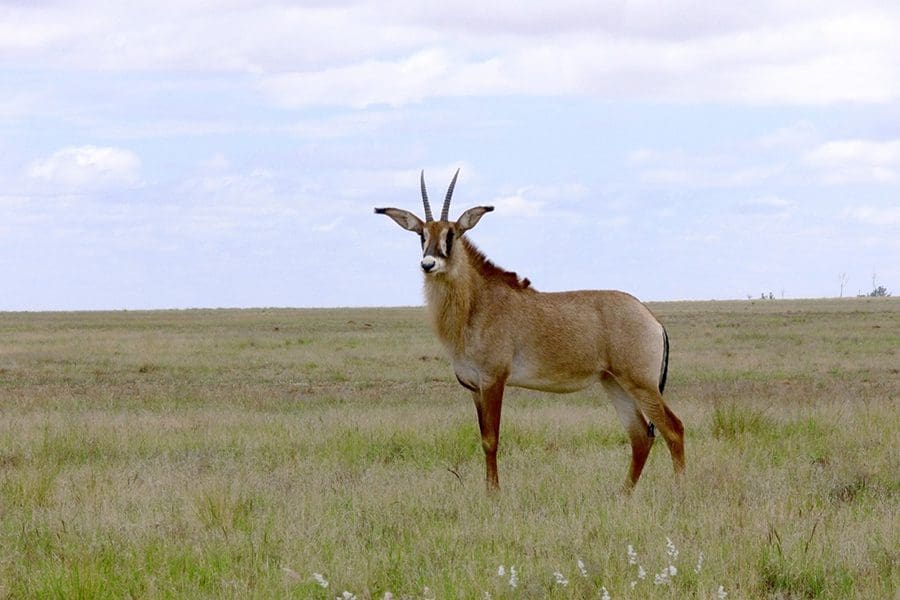
Ranking second for the title of largest African antelope, the roan antelope have a thick neck and short-coupled body, not dissimilar to a horse. Their mohawk-like mane, grey coat with a touch of chestnut, and large ears make them a striking and distinguishable addition to any South Luangwa safari. Roan antelope form social herds of around 20 members and communicate with ‘whistle' variations.
Where Can You See Roan Antelope in South Luangwa?
Roan antelope are categorised as one of the more rare sightings as they typically habituate remote parts of South Luangwa National Park, such as the Muchinga escarpment.
Hippotragus niger
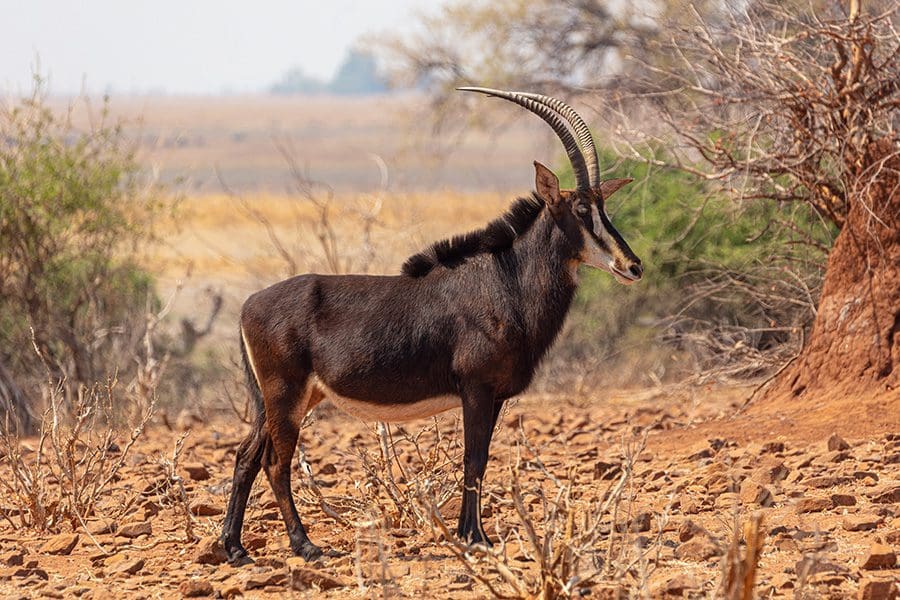
Undoubtedly one of Africa's best looking antelope, and one of the most combative. Their size, solid stature, and large backwards-sloping horns make them an imposing opponent. While the males sport a glossy, ink-like coat with a white belly and face, females are smaller, chestnut in colour, and possess straighter horns. When defending against predators, males will go down on their front knees and strike their opponent with their extensive horns – their methods are decidedly effective and have been known to take down the odd lion.
Where Can You See Sable Antelope in South Luangwa?
Similarly to its Hippotragus relation, the roan antelope, these black-coated beauties are considered a less common sighting in the park.
Kobus vardonii
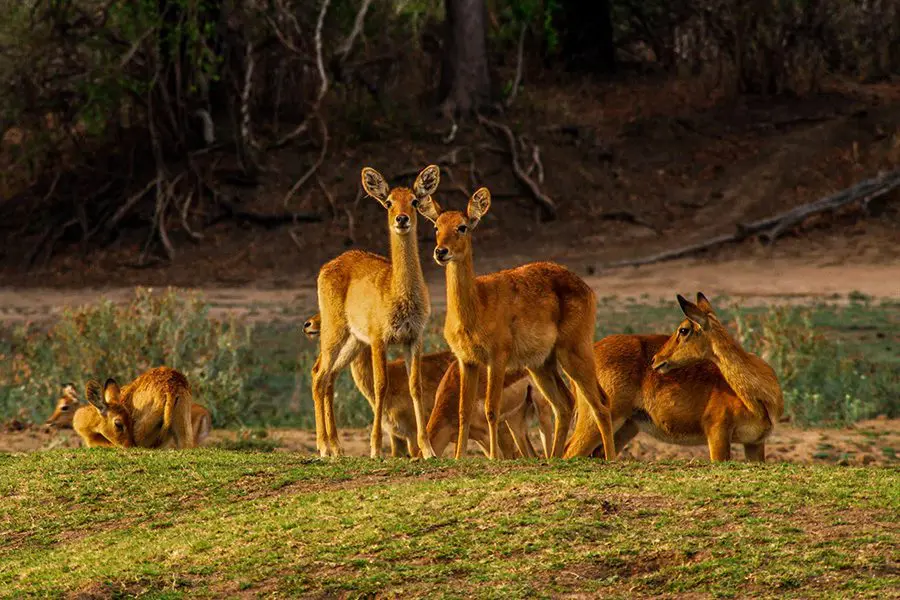
Puku Antelope are similar in size to Impala, and just as common, but with more fur, a burnt orange coat, and similarly ringed horns that extend skyward in a v-shape. These grazers are found in small herds and are typically found near floodplains or permanent water sources. This small buck is the namesake for the epic eco-friendly Puku Ridge Camp found within the wild heart of South Luangwa, a place which is always afforded ample sightings of the local puku.
Where Can You See Puku Antelope in South Luangwa
Puku antelope can be found in the Luangwa Valley and are most commonly found on floodplains and near the Luangwa River or its tributaries.
Sylvicapra grimmia
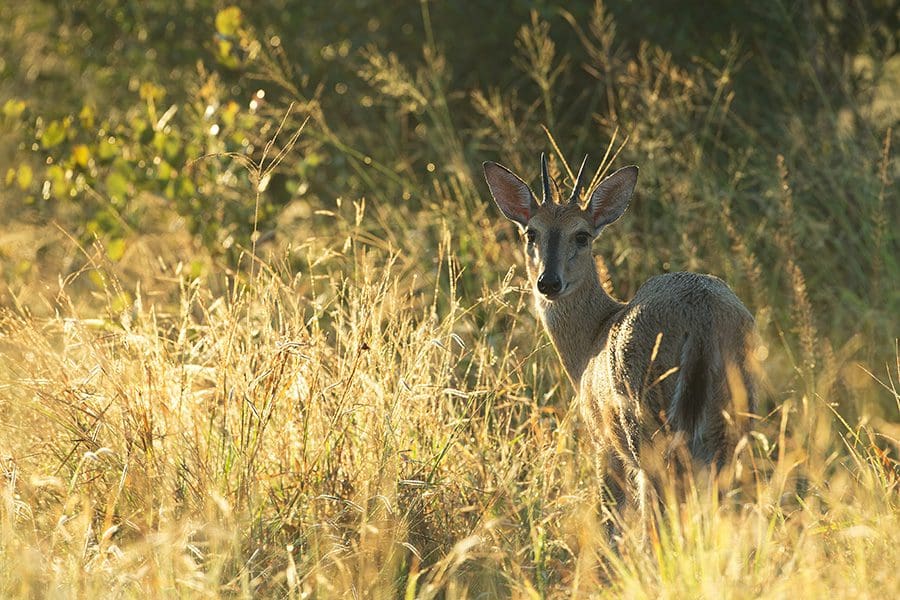
This small greyish brown antelope gets its name from the Afrikaans word ‘duiker', which means ‘to dive', given its propensity to duck into bushes when threatened. They're unique in their capacity to live independently of water sources and sustain themselves on leaves, fruit, and seeds. Duiker are also the few antelope who eat insects. As a dimorphic species, only the males have small horns and females are slightly taller and heavier.
Where Can You See Duiker Antelope in South Luangwa
Duiker antelope are less commonly found near the Luangwa River but are typical residents in the backcountry of the valley. They are also spotted a little more frequently in the Green Season due to higher vegetation density.
Aepyceros Malampus

Impala are arguably the most common sighting in South Luangwa Park, but are frequently confused with puku. Identifiable by their tri-coloured coats which progress from a reddish-brown, to a light beige, to white on their belly. The species are synchronised breeders and all give birth within a few days of each other at the beginning of the wet season (usually early November) – not only does this ensure there is ample food and water around but safety in numbers.
Where Can You See Impala in South Luangwa?
Impala are a dime a dozen in South Luangwa National Park and are a common sighting.
Tragelaphus strepsiceros
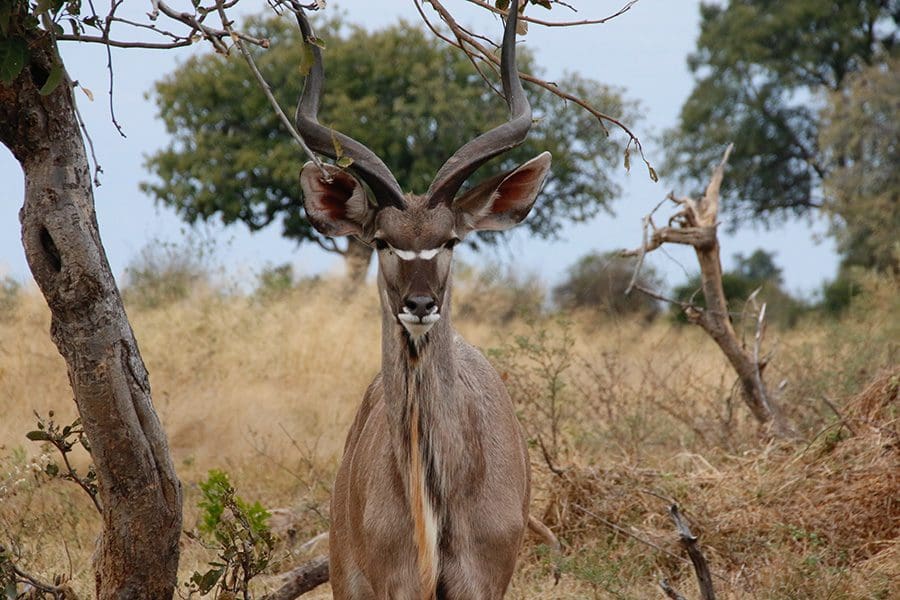
One of the most attractive antelopes found in South Luangwa is the Kudu. Characterised by their tall spiralling horns (for the males), radar-like ears, and grey coat with thin white stripes along their body. Kudu are highly alert and attuned to any potential danger, which can make them tricky to approach, not to mention their affinity for more dense vegetation. When threatened, they give out a hoarse ‘bark' to alert the herd and take off.
Where Can You See Kudu in South Luangwa?
Kudu are fairly common in South Luangwa National Park, but are not always easy to spot and can be quite flighty. Fortunately, with the uptick of electric and solar-powered game vehicles, Kudu sightings are more common. Walking safaris also provide a stealthy sighting possibility.
There are also other exceptional wildlife species in the area, some of which are extremely rare, such as pangolin and aardvark – two very shy species who are usually most active at night. Their nocturnal tendencies make them tricky to spot, especially as many parks do not allow spot lit game drives.
South Luangwa National Park is also an aviary enthusiast's dream destination with over 400 recorded species – both resident and migratory. One of the most striking and sought after sightings when it comes to birds of South Luangwa National Park is of the Southern Carmine bee-eater. These brightly coloured beauties migrate to the park between August and September. A host of exciting birdlife provide a continuous chorus to any safari, particularly during the Green Season – November to April.
The best ways to see wildlife go hand in hand with the top things to do in South Luangwa – in addition to a visit to an indulgent bush spa, of course. Fortunately, the park has allowed the use of spotlights making night drives an exciting possibility, depending on the camp or lodge.
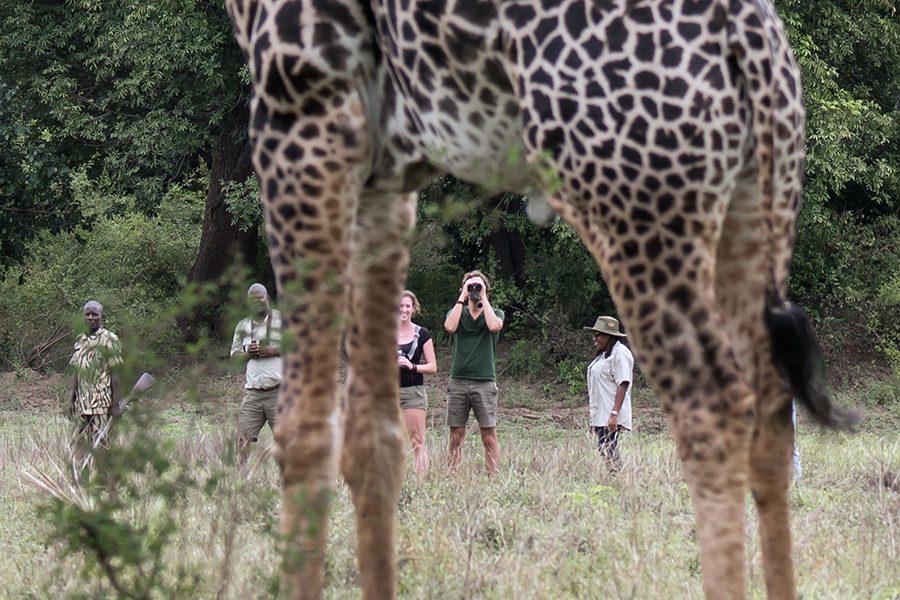
As the official birthplace of the walking safari, this has to be the first mentioned way to enjoy the park's wildlife. Step into the exquisite wilderness of South Luangwa National Park with a tried and tested guide filled to the brim with facts, knowledge, and fantastic tracking skills. Each and every walking safari will be unique and sightings can never be guaranteed, but it's the perfect way to collect intimate details of the park by trekking through it on foot.
There is no more thrilling feeling than completing a track from start to sighting and provides an entirely different viewing perspective than that from a game vehicle. Fortunately, given the lack of a rumbling diesel engine, it's easier to go unnoticed on foot and not spook some of the flightier residents of the park.
Walking safaris can vary from a brief outing into a certain area or several hours spent discovering the mysteries of the African bush, to an authentic overnight experience complete with campfire, storytelling, and an evening spent under the vibrant night sky.
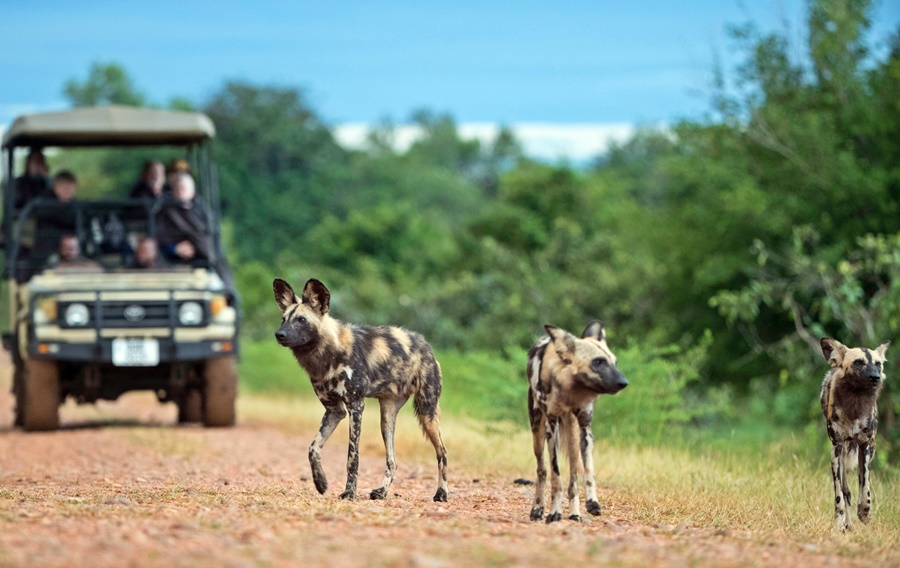
One of the most common ways of exploring a safari destination is in a kitted out 4×4 vehicle – be it open air or canvas topped. Each game drive is accompanied by at least one safari guide, who typically find immense joy in sharing their knowledge and answering questions.
Guides will use their tenure in the park to hunt down wildlife hiding in their regular spots or follow fresh tracks for an in the moment adventure. Often game drives are combined with a bush breakfast or sundowners with a lovely view before heading back for lunch or dinner.
South Luangwa National Park is also home to several camps and lodges that now offer electric safari vehicles powered by the near constant Zambian sun. Not only does this reduce their environmental footprint, but reduces noise pollution, and allows for more close-up sightings. Shawa Luangwa Camp was the first property to introduce silent safaris in the park.
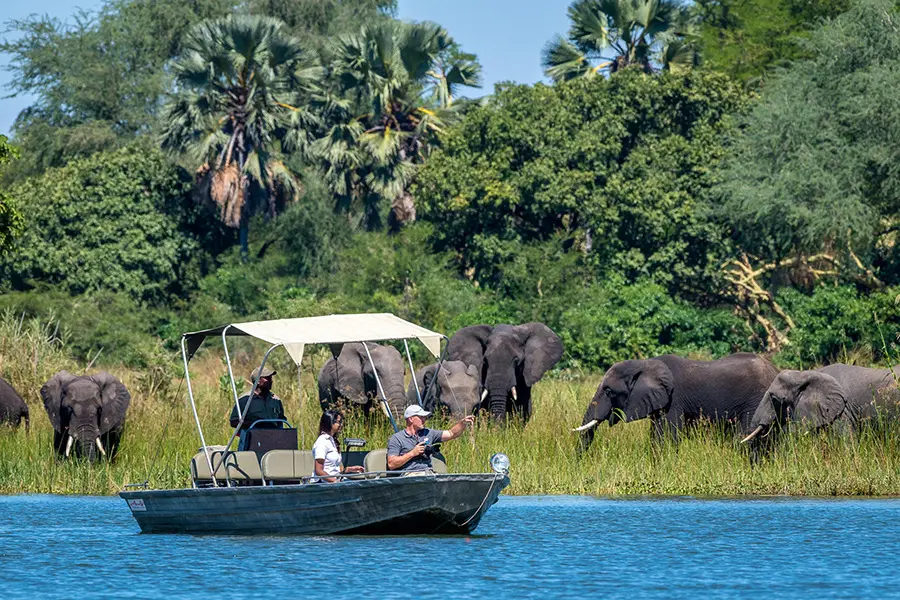
When water levels allow, the Luangwa River offers visitors a fantastic spot from which to spot river-dwellers and other wildlife from a unique perspective. While the rainy season makes the river banks lush, beautiful, and budding with birdlife and new babies, it's the dry months that make for the most sightings. Often boat cruises make for a fantastic photographic opportunities.
Some properties also offer canoes or similarly sized self-powered boats for river excursions accompanied by a guide.
If South Luangwa National Park and its wildlife have lured you in, perhaps it's time to book a trip to see them in the flesh. Chat with one of our African Safari Experts and create the perfect tailor-made safari!